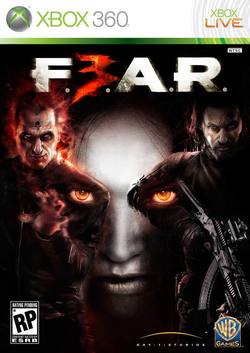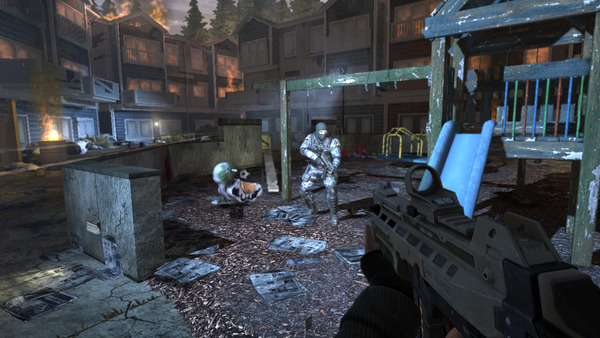 It isn’t technically all that important for a small site like mine to worry about such things as journalistic integrity, but I do my best to do right by them anyway. There’s a reason why this isn’t labeled a “review”. My experience with F.E.A.R. 3 includes only the single player and in the grand scheme of the game’s feature set, that’s not a comprehensive look at all it has to offer. Thus my reluctance of doing a traditional “review”.
It isn’t technically all that important for a small site like mine to worry about such things as journalistic integrity, but I do my best to do right by them anyway. There’s a reason why this isn’t labeled a “review”. My experience with F.E.A.R. 3 includes only the single player and in the grand scheme of the game’s feature set, that’s not a comprehensive look at all it has to offer. Thus my reluctance of doing a traditional “review”.
Precisely this same train of thought strongly compels me to share my thoughts on the game anyway. You see, F.E.A.R. 3 is designed as a multiplayer experience first and foremost.
“Surely you jest!” I hear you mocking sarcastically. “A shooter that places multiplayer on a higher pedestal than single player? Such things have never been heard of!”
The truth intended by your mocking is correct, of course. The single player shooter is a sad and abandoned animal, having been neglected and forgotten in favor of the far more lucrative multiplayer shenanigans that comprise the overwhelming majority of the online gaming scene these days.
F.E.A.R. has always been different to me. I’m not sure it actually is different, as this isn’t the first F.E.A.R. to place a heavy emphasis on multiplayer modes. I still remember being miffed at how many of F.E.A.R. 2’s achievements centered around its multiplayer efforts.
I never had an interest in F.E.A.R. 2’s multiplayer, and I have none for F.E.A.R. 3’s either. They may well be fantastic, and I do, in fact, hear from proper reviews of F.E.A.R. 3 that it is a far better game when shared with a friend. That doesn’t change the fact that I don’t want to play F.E.A.R. with others. I want to lock myself in a room, turn off all the lights, and soak up the wonderful horror atmosphere. Even the shooting itself seems secondary to me, more a way to relieve tension than the primary draw.
F.E.A.R. 3 moves the focus squarely to action, and specifically action with other people. The campaign can be played all the way through in an admittedly novel asymmetrical co-op mode. The proper multiplayer features some unique-sounding team-based modes that do an admirable job of trying something different than the “deathmatch/capture the flag/king of the hill” norm.
Unfortunately, these additions have come at a cost. The very reason I am interested in the series in the first place, the engrossing single-player experience, has been compromised in favor of multiplayer. The campaign is so relentlessly focused on action that it never has time to build tension for the horror to work. The battles are so clearly built for two people that they often feel too big and tedious if you’re going into them by yourself.
Considering F.E.A.R. made its name on atmosphere, abandoning it almost entirely in an attempt to cram unwanted multiplayer into the game is a cardinal sin that I simply cannot forgive. Those who look to this game for the scares, the atmosphere, and the story are likely to leave disappointed.
It’s a shame, because the basics are solid. In the interest of full disclosure, I should mention that I find myself indescribably sick of shooters lately, and the cover-based variety in particular has grown tremendously tedious. On a related note, F.E.A.R. 3 has been turned into a full-on cover-based shooter.
My boredom in the first couple of hours, which consist almost entirely of wave-based combat scenarios strung together by short, boring hallways, was nearly tangible.
That said, the mechanics are good. Once the game found its stride a few hours in and started feeling a bit more like F.E.A.R., I started enjoying it more. If you’re less sick of the genre than I am, you’ll probably have fun.
The mechanics do occasionally get in the way, though the issues are small enough that I hesitate to spend much time describing them for fear of overstating the significance of the problems. The primary issue is with the new cover system. It works well on the whole, but is sometimes overly sticky (or not enough so, depending on which is less convenient for you at the time). Switching cover positions or coming out of cover is often more of a pain than it should be. A few rough edges rear their head as well, such as the time I encountered an invisible wall shoved right in the middle of the hallway I was supposed to be running down, nearly blocking my progress. Still, on the whole the franchise’s signature mix of slow-motion abilities, plenty of splattery gore, and punchy gunfire continue to be satisfying.
Solid mechanics don’t change the fact that certain combat scenarios the game throws at you just aren’t fun with one person. A certain enemy type that shows up one too many times loves to run away while spawning seemingly never-ending waves of minions for you to deal with whilst you try to take him down and stop the torrent of baddies. Dealing with this as a lone gunman is nothing short of maddening. Other areas are just as bad, pitting you against too many enemies for you to comfortably deal with alone or throwing you into combat areas so large that you almost begin to feel lonely without someone else to share the space with you.
Truth be told, it’s a little hard to criticize F.E.A.R. 3 for failing to bring new ideas to the franchise when, let’s face it, F.E.A.R. 2 didn’t exactly reinvent the wheel. F.E.A.R. 2 was great because it had more environmental variety, atmosphere in spades, and much greater production values, not because of the load of new ideas it brought to the table. F.E.A.R. 3 can no longer rely on production value as its trump card (as it looks sadly behind the curve for the most part), but instead of innovating, it trots out every single one of those same ideas all over again and fails to add a single new one to the mix. The same bag of tricks doesn’t cut it three times in a row.
The game’s attempts to scare you are laughably transparent. I guessed almost every one of them before they happened. I love freaky little Alma, but let’s face it, seeing her pop up and then quickly vanish as you come around a corner for the 227th time isn’t scary any more. Every lame attempt at a scare is of the “cheesy jump” variety and none of them work. Only a precious few areas in the game feel even remotely tense. You can’t just go directly from shooting into jump scare into more shooting, which F.E.A.R. 3 tries far too many times. You need quiet, a false sense of security, and growing unrest.
In its later moments, the team does show that it is capable of grasping this concept, delivering some cool environments. Amongst the dismally dreary locations that make up most of the short campaign, F.E.A.R. 3 delivers a few morsels that felt like parts of a genuine F.E.A.R. game. A dilapidated off-brand Wal-Mart in particular is one of the game’s finest stretches. The pacing feels more like a F.E.A.R. game than a run-of-the-mill shooter, new enemies that are faster and more threatening keep you on your toes, and a maze of glowing HDTVs is a lot creepier than it should be. Even at its best, F.E.A.R. 3 doesn’t hold up to earlier entries. A few environments are memorable, a few set pieces spectacular, but on the whole it feels like it’s going through the motions. Fear does not thrive in a predictable environment.
The labyrinthian and often indecipherable plot of the F.E.A.R. series is surely written off by many as unimportant, but I’ve always found it to posses a wonderful B-movie charm that kept my interest. It was my desire to see where the story went after the memorable cliffhanger at the end of F.E.A.R. 2 that kept my hope for the game alive. No matter its other problems, there was still the chance it would take Alma’s dark, twisted tale to new and interesting places.
F.E.A.R. 3 shows all the signs of a story being pushed beyond its natural limits. F.E.A.R. was compelling when it was simple: Alma will fuck you up; destroy her. Learning the story of her origins in the first game was fascinating, turning her into a character equal parts sympathetic and terrifying. As the tale spirals into increasingly complex scenarios, it gets further away from what made it work in the first place. All the nonsense about family ties, brothers coming back from the dead, and psychic rape babies is just nonsense. It’s like a Tim Burton-helmed soap opera gone horribly wrong. Alma is no longer a threat, nothing makes any damn sense, both of the two possible endings are meaningless cliffhangers that fail to make this entry individually satisfying, and the attempt to add backstory to this twisted universe has clearly backfired. Maybe Alma’s new undoubtedly demonic offspring will give this series an opportunity to reboot with its next installment, but for now it should be written off as a loss.
F.E.A.R. 3 is a good thing stretched too thin. It isn’t fair to call it a bad game. Mechanically it’s fairly solid, if hardly revolutionary, and the atmosphere certainly has its moments. More than anything it’s disappointing. This installment brings a shift in direction for the franchise that plays against its strengths. As laudable as the attempts at innovation in F.E.A.R. 3’s multiplayer modes are, that’s not what I want out of F.E.A.R. With F.E.A.R. 3, the game’s horror aspect has been thrown under the bus in an attempt to grab some of the multiplayer pie. This series used to be a refreshing change of pace for me, but now it’s just another damn shooter.

